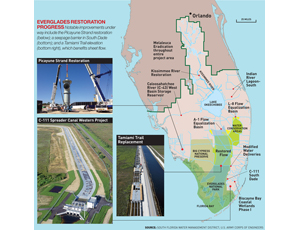
In its latest report, the National Research Council tempered its mild praise for "fairly modest progress" in the $13.5-billion Everglades restoration plan with its concerns over climate change, rising sea levels and the invasion of non-native plant and animal species.
The fifth congressionally mandated biennial report on the Comprehensive Everglades Restoration Plan (CERP), released on June 26 by a 14-member scientific committee, criticizes the financial, procedural and policy constraints that have impeded project implementation. Those constraints include infrequent passage of Water Resources Development Acts by Congress. The committee called for expedited implementation to avert further degradation of the ecosystem.
To people outside Florida, Everglades restoration is an immense money pit advancing at a snail's pace. But the Everglades are also essential to the health of the South Florida economy as well as its ecosystem, being a principal source of public water supply in addition to being an attraction for tourists.
CERP progress flows at the same languid rate as the water through the Glades, but it does flow. The report highlights successes such as raising a mile of the Tamiami Trail to unblock the flow of water into the Glades; near-completion of Picayune Strand restoration due to a failed residential development; ecosystem responses to phased implementation of several projects that restored "sheet flow" into Florida and Biscayne bays; and 85% completion of the Kissimmee River Restoration to undo a disastrous channelization of the river in the 1960s.
But the Everglades program needs updating to integrate climate change into future ongoing analysis and monitoring. Implementation priorities must be revised "to focus resources on those projects with the greatest potential to avert ecosystem degradation and provide long-term benefits considering sea-level rise and potential changes in temperature and precipitation," the report says.
Nearing Completion
Before the 1960s, the Kissimmee River, headwaters of the Everglades, was a 103-mile-long meandering stream feeding into Lake Okeechobee; then, the Corps converted it into the 40-mile-long C-38 canal for flood control. Now, at a cost of $727 million, its restoration is 86% complete. "This is the crown jewel of ecosystem restoration," says Howard Gonzales, ecosystem branch chief for the Corps of Engineers Jacksonville District in Florida. When natural conditions are restored, "ecosystems respond almost immediately," he says. Five projects remain to be awarded, and they are "relatively small—backfilling and structures to keep backfill in place," he says. Completion is scheduled for 2019.
Built in the 1920s, the Tamiami Trail, part of U.S. Route 41, effectively dammed the flow of water into the Everglades, devastating its ecology. In December 2013, an $81-million, mile-long section was completed, elevating the road to allow water to flow freely. In August 2013, the state of Florida committed $90 million for its half of the cost to elevate an additional 2.6-mile segment of the highway.


Post a comment to this article
Report Abusive Comment